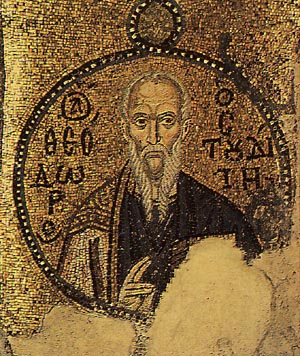Mănăstirea Studion
| Acest articol (sau părți din el) este propus spre traducere din limba engleză!
Dacă doriți să vă asumați acestă traducere (parțial sau integral), anunțați acest lucru pe pagina de discuții a articolului. |

Istorie
Mănăstirea a fost fondată în anul 462 sau 463 cu monahi din mănăstirea achimiților (Acoemetae) de către consulul Studios, un demnitar roman creștin, în cartierul Psamathia din Constantinopol. Mănăstirea a fost închinată sfântului Ioan Botezătorul. During the disputes of the late fifth century, the monks of the Studion, and with Daniel Stâlpnicul, remained steadfast for Orthodoxy relative to the issues of the Eutychian debates and monophysitism in disputes among Patriarch Acacius of Constantinople, the Roman emperors Zeno I and Basiliscus, the patriarchs of Alexandria, and the bishops of Rome.
During the eighth and nine centuries the monastery, led by a series of zealous abbots, maintained strong Orthodox positions during the iconoclastic period. Hegumen Sabbas zealously defended the Orthodox doctrines against the iconoclasts during the Seventh Ecumenical Council in 787. About 798, Theodore of the Sukkudion monastery was asked by the Empress Irene to lead the Studion monastery. Under the leadership of Theodore the Studite, as he became known, the monastery reached its peak in fame as it fostered academic and spiritual study. The defense of Orthodox belief, however, was not without its dangers. Theodore and the monks were often harassed, even driven from the monastery during Theodore’s tenure as abbot.
The monastery was led by a succession of able abbots after St Theodore. These abbots included Naucratius, Theodore’s disciple, who re-established discipline after the chaotic iconoclastic period closed. The monastery maintained its position of importance from abbot Nicholas in mid ninth century through abbot Simeon in the eleventh century after which Studion’s brilliance began to fade. The monastery was noted at its height for its intellectual life, its school of calligraphy that was established by Theodore, as a center of religious poetry, and for its assemblage of theological writers.
The monastery was seriously damaged during the Crusader conquest of Constantinople in 1204 and did not recover physically until 1290. By this time the stature of the Studion monastery had decayed further. With the capture of Constantinople by the Ottoman Turks in 1453, the monastery was largely destroyed. The only part of the monastery to survive to modern times is the Cathedral of St. John the Forerunner, which is probably the oldest church in modern day Istanbul. The fifth century basilica had been converted into a mosque. The ruins of the monastery complex now lay abandoned and subject to looting by the local people looking for material to repair their residences.
Surse
Legături externe
- ro Mănăstirea Studion - articol în situl crestinortodox.ro
- en Monastery of Saint John of Stoudios (Pictorial reconstructions)
- en Rule of the Stoudios Monastery
- en Byzantine Medieval Hypertexts - Theodore Psalter
